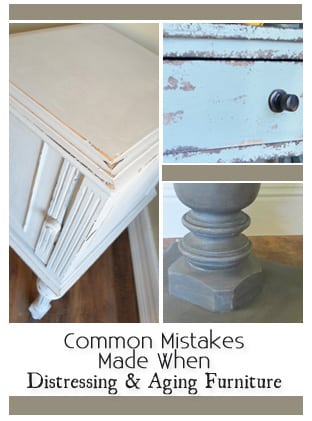Distressing and aging painted furniture seems like something you can’t really go wrong with. But, it’s actually much harder to do well than it looks. There is definitely an art to it. Here are some common problems I have run into that can “ruin” a distressed paint finish.
Distressing/Sanding Before The Paint Has Fully Dried
I have run into problems when I have sanded and distressed pieces before letting the paint fully dry. In my opinion it’s best to let the paint dry overnight before starting the distressing process, or around 8+ hrs.
If you start distressing and sanding too early, you can end up with the paint balling up or peeling instead of sanding off in a natural way.

Distressing With Sandpaper That is Too Harsh
A distressed piece looks better if it’s distressed with a 320-400 grit sandpaper. 220 is probably okay too, but the lower the grit of the sandpaper, the harsher it is on the paint and can leave scratch marks all over it, instead of an overall worn look, it just looks like the piece has been scratched up. Higher grits of sandpaper look better.
Less is More
When applying dark or light glaze or wax to create an aged look. In my opinion, less is more. I think pieces with natural looking tints looks better than pieces I’ve seen where glaze or dark wax is just piled on. I think subtler looks look cleaner and more beautiful.
Primer Showing Through
If you are planning to do a lot of heavy distressing on a piece, it might be better to either have your primer tinted to match the paint or to do enough sanding on your piece that you don’t need to apply primer before painting.
I’ve run into problems when distressing a piece and as I’m trying to get the wood to show through, the primer is showing through too – super frustrating.








